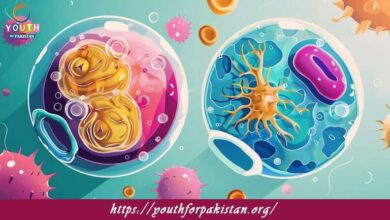11th Class Physics Chapter 11 MCQs with Answers

Dive into energy transfer concepts with Heat and Thermodynamics MCQs, featuring questions on laws of thermodynamics, heat engines, and entropy. These Chapter 11 quizzes are tailored for 11th Class Physics students.
Heat is a form of .
a) Mechanical energy
b) Electrical energy
c) Kinetic energy
d) Thermal energy
The SI unit of heat is .
a) Joule
b) Watt
c) Calorie
d) Kelvin
Heat transfer by direct contact between particles of a substance is called .
a) Conduction
b) Convection
c) Radiation
d) Conversion
The process of heat transfer through the emission of electromagnetic waves is called
a) Conduction
b) Convection
c) Radiation
d) Conversion
The specific heat capacity of a substance is defined as the amount of heat required to raise the temperature of .
a) One mole of the substance by one degree Celsius
b) One gram of the substance by one degree Celsius
c) One kilogram of the substance by one degree Celsius
d) One liter of the substance by one degree Celsius
Which of the following materials is a good conductor of heat?
a) Wood
b) Plastic
c) Copper
d) Styrofoam
Which law of thermodynamics states that energy cannot be created or destroyed, only converted from one form to another?
a) First law of thermodynamics
b) Second law of thermodynamics
c) Third law of thermodynamics
d) Zeroth law of thermodynamics
Which law of thermodynamics states that heat naturally flows from regions of higher temperature to regions of lower temperature?
a) First law of thermodynamics
b) Second law of thermodynamics
c) Third law of thermodynamics
d) Zeroth law of thermodynamics
The efficiency of a heat engine is given by .
a) (Qin – Qout) / Qin
b) (Qout – Qin) / Qin
c) Qin / (Qout – Qin)
d) (Qout – Qin) / Qout
Which process involves the conversion of a solid directly into a gas without passing through the liquid state?
a) Melting
b) Sublimation
c) Condensation
d) Vaporization
The triple point of a substance corresponds to the conditions of temperature and pressure at which the substance exists as .
a) Solid only
b) Liquid only
c) Gas only
d) Solid, liquid, and gas phases are in equilibrium
The process of heat transfer in which heated fluid rises and cooler fluid sinks is called
a) Conduction
b) Convection
c) Radiation
d) Transformation
The heat required to raise the temperature of one gram of a substance by one degree
Celsius is called .
a) Specific heat capacity
b) Latent heat
c) Molar heat capacity
d) Calorific value
Which of the following is an example of a good insulator?
a) Aluminum
b) Glass
c) Iron
d) Silver
The transfer of heat energy within a fluid (liquid or gas) due to density differences is known as .
a) Conduction
b) Convection
c) Radiation
d) Transformation
The transfer of heat between two objects that are in direct physical contact with each other is called .
a) Conduction
b) Convection
c) Radiation
d) Transformation
Which law of thermodynamics states that absolute zero cannot be reached?
a) First law of thermodynamics
b) Second law of thermodynamics
c) Third law of thermodynamics
d) Zeroth law of thermodynamics
The specific heat capacity of water is _ .
a) High
b) Low
c) Same as air
d) Zero
The heat required to change a solid into a liquid at its melting point is called _ .
a) Specific heat capacity
b) Latent heat of fusion
c) Molar heat capacity
d) Calorific value
The heat required to change a liquid into a gas at its boiling point is called .
a) Specific heat capacity
b) Latent heat of fusion
c) Latent heat of vaporization
d) Calorific value
The unit of specific heat capacity in the SI system is .
a) Joules per gram per degree Celsius
b) Joules per kilogram per degree Celsius
c) Joules per mole per degree Celsius
d) Joules per liter per degree Celsius
The transfer of heat through electromagnetic waves is called .
a) Conduction
b) Convection
c) Radiation
d) Transformation
When a gas is compressed and no heat is allowed to enter or leave the system, the process is .
a) Isothermal
b) Adiabatic
c) Isobaric
d) Isometric
The lowest possible temperature that any substance can reach is .
a) 0°C
b) 0 K
c) 0°F
d) 0 R
Which law of thermodynamics states that as energy is transferred or transformed, more and more of it is wasted or becomes unavailable?
a) First law of thermodynamics
b) Second law of thermodynamics
c) Third law of thermodynamics
d) Zeroth law of thermodynamics
A gas will cool down during .
a) Adiabatic expansion
b) Adiabatic compression
c) Isothermal expansion
d) Isothermal compression
The transfer of heat energy by electromagnetic waves is most effective through
a) Solids
b) Liquids
c) Gases
d) Vacuum
The heat required to change a gas into a liquid at its boiling point is called .
a) Specific heat capacity
b) Latent heat of fusion
c) Latent heat of vaporization
d) Calorific value
The heat required to raise the temperature of one mole of a substance by one degree
Celsius is called .
a) Specific heat capacity
b) Latent heat
c) Molar heat capacity
d) Calorific value
Which of the following is an example of an exothermic process?
a) Melting of ice
b) Boiling of water
c) Condensation of water vapor
d) Burning of wood
The first law of thermodynamics is also known as the law of .
a) Conservation of energy
b) Entropy
c) Reciprocal proportions
d) Constant composition
Which of the following statements is true about the second law of thermodynamics?
a) It states that energy cannot be created or destroyed.
b) It states that heat naturally flows from a cooler body to a hotter body.
c) It states that the entropy of a closed system tends to increase over time.
d) It states that the entropy of a closed system remains constant over time.
In which of the following processes does the entropy decrease?
a) Melting of ice
b) Freezing of water
c) Evaporation of water
d) Boiling of water
The heat transfer in which energy is transferred by actual motion of fluid particles is called .
a) Conduction
b) Convection
c) Radiation
d) Transformation
The specific heat capacity of a substance depends on its .
a) Mass
b) Volume
c) Pressure
d) Nature
Which of the following is an example of an endothermic process?
a) Melting of ice
b) Boiling of water
c) Condensation of water vapor
d) Sublimation of dry ice
The heat required to change a liquid into a gas at its boiling point is called .
a) Specific heat capacity
b) Latent heat of fusion
c) Latent heat of vaporization
d) Calorific value
The heat required to change a solid into a liquid at its melting point is called _ .
a) Specific heat capacity
b) Latent heat of fusion
c) Molar heat capacity
d) Calorific value
The heat transfer in which energy is transferred by actual motion of fluid particles is called .
a) Conduction
b) Convection
c) Radiation
d) Transformation
The specific heat capacity of a substance depends on its .
a) Mass
b) Volume
c) Pressure
d) Nature
Which of the following is an example of an endothermic process?
a) Melting of ice
b) Boiling of water
c) Condensation of water vapor
d) Sublimation of dry ice
Which of the following is an example of an exothermic process?
a) Melting of ice
b) Boiling of water
c) Condensation of water vapor
d) Burning of wood
The first law of thermodynamics is also known as the law of .
a) Conservation of energy
b) Entropy
c) Reciprocal proportions
d) Constant composition
In which of the following processes does the entropy decrease?
a) Melting of ice
b) Freezing of water
c) Evaporation of water
d) Boiling of water
Which of the following statements is true about the second law of thermodynamics?
a) It states that energy cannot be created or destroyed.
b) It states that heat naturally flows from a cooler body to a hotter body.
c) It states that the entropy of a closed system tends to increase over time.
d) It states that the entropy of a closed system remains constant over time.
When a gas is compressed and no heat is allowed to enter or leave the system, the process is .
a) Isothermal
b) Adiabatic
c) Isobaric
d) Isometric
The transfer of heat through electromagnetic waves is called .
a) Conduction
b) Convection
c) Radiation
d) Transformation
The unit of specific heat capacity in the SI system is .
a) Joules per gram per degree Celsius
b) Joules per kilogram per degree Celsius
c) Joules per mole per degree Celsius
d) Joules per liter per degree Celsius
A gas will cool down during .
a) Adiabatic expansion
b) Adiabatic compression
c) Isothermal expansion
d) Isothermal compression
The lowest possible temperature that any substance can reach is .
a) 0°C
b) 0 K
c) 0°F
d) 0 R
Which law of thermodynamics states that as energy is transferred or transformed, more and more of it is wasted or becomes unavailable?
a) First law of thermodynamics
b) Second law of thermodynamics
c) Third law of thermodynamics
d) Zeroth law of thermodynamics
The specific heat capacity of water is _ .
a) High
b) Low
c) Same as air
d) Zero
The heat required to change a gas into a liquid at its boiling point is called .
a) Specific heat capacity
b) Latent heat of fusion
c) Latent heat of vaporization
d) Calorific value
The heat required to change a solid into a liquid at its melting point is called _ .
a) Specific heat capacity
b) Latent heat of fusion
c) Molar heat capacity
d) Calorific value
The heat transfer in which energy is transferred by actual motion of fluid particles is called .
a) Conduction
b) Convection
c) Radiation
d) Transformation
The specific heat capacity of a substance depends on its .
a) Mass
b) Volume
c) Pressure
d) Nature
Which of the following is an example of an exothermic process?
a) Melting of ice
b) Boiling of water
c) Condensation of water vapor
d) Burning of wood
The first law of thermodynamics is also known as the law of .
a) Conservation of energy
b) Entropy
c) Reciprocal proportions
d) Constant composition
In which of the following processes does the entropy decrease?
a) Melting of ice
b) Freezing of water
c) Evaporation of water
d) Boiling of water
Which of the following statements is true about the second law of thermodynamics?
a) It states that energy cannot be created or destroyed.
b) It states that heat naturally flows from a cooler body to a hotter body.
c) It states that the entropy of a closed system tends to increase over time.
d) It states that the entropy of a closed system remains constant over time.
If you are interested to enhance your knowledge regarding Physics, Chemistry, Biology, and Computer please click on the link of each category, you will be redirected to dedicated website for each category.





